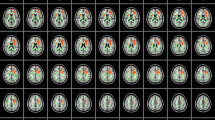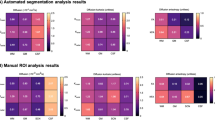Abstract
Background
Neurofibromatosis type 1 (NF1) is a hereditary disease with a dominant autosomal pattern. In children and adolescents, it is frequently associated with the appearance of T2-weighted hyperintensities in the brain’s white matter. MRI with diffusion tensor imaging (DTI) is used to detect white matter abnormalities by measuring fractional anisotropy (FA).
Objective
This study employed DTI to evaluate the relationship between FA patterns and the findings of T2 sequences, with the aim of improving our understanding of anatomical changes and microstructural brain abnormalities in individuals with NF1.
Materials and methods
Forty-four individuals with NF1 and 20 control subjects were evaluated. The comparative analysis of FA between NF1 and control groups was based on four predetermined anatomical regions of the brain hemispheres (basal ganglia, cerebellum, pons, thalamus) and related the presence or absence of T2-weighted hyperintensities in the brain, which are called unidentified bright objects (UBOs).
Results
The FA values between the groups demonstrated statistically significant differences (P ≤ 0.05) for the cerebellum and thalamus in patients with NF1, independent of the occurrence of UBOs.
Conclusions
Diffusion tensor MR imaging confirms the influence of UBOs in the decrease of FA values in this series of patients with NF1. Additionally, this technique allows the characterization of microstructural abnormalities even in some brain regions that appear normal in conventional MR sequences.



Similar content being viewed by others
References
Riccardi VM (1992) Neurofibromatosis phenotype, natural history and pathogenesis. Johns Hopkins University Press, Baltimore
Mentzel HJ, Seidel J, Fitzek C et al (2005) Pediatric brain MRI in neurofibromatosis type I. Eur Radiol 15:814–822
U.S. Dept. of Health and Human Services (1987) Neurofibromatosis. NIH Consensus Development Program. Available via http://consensus.nih.gov/1987/Neurofibromatosis064html.htm. Accessed 25 Aug 2011
Mulvihill JJ, Parry DM, Sherman JL et al (1990) NIH conference neurofibromatosis 1 (Recklinghausen disease) and neurofibromatosis 2 (bilateral acoustic neurofibromatosis): an update. Ann Intern Med 113:39–52
DeBella K, Poskitt K, Szudek J et al (2000) Use of “unidentified bright objects” on MRI for diagnosis of neurofibromatosis 1 in children. Neurology 54:1646–1651
Sevick RJ, Barkovich AJ, Edwards MS et al (1992) Evolution of white matter lesions in neurofibromatosis type 1: MR findings. AJR 159:171–175
Curless RG (2000) Use of “unidentified bright objects” on MRI for diagnosis of neurofibromatosis 1 in children. Neurology 55:1067–1068
DiPaolo DP, Zimmerman RA, Rorke LB et al (1995) Neurofibromatosis type 1: pathologic substrate of high signal intensity foci in the brain. Radiology 195:721–724
Kraut MA, Gerring JP, Cooper KL et al (2004) Longitudinal evolution of unidentified bright objects in children with neurofibromatosis-1. Am J Med Gen A 129:113–119
Itoh T, Magnaldi S, White RM et al (1994) Neurofibromatosis type 1: the evolution of deep gray and white matter MR abnormalities. AJNR 15:1513–1519
Mamata H, Mamata Y, Westin CF et al (2002) High-resolution line scan diffusion tensor MR imaging of white matter fiber tract anatomy. AJNR 23:67–75
Zamboni SL, Loenneker T, Boltshauser E et al (2007) Contribution of diffusion tensor MR imaging in detecting cerebral microstructural changes in adults with neurofibromatosis type 1. AJNR 28:773–776
Wei CW, Guo G, Mikulis DJ (2007) Tumor effects on cerebral white matter as characterized by diffusion tensor tractography. Can J Neurol Sci 34:62–68
Jellison BJ, Field AS, Medow J et al (2004) Diffusion tensor imaging of cerebral white matter: a pictorial review of physics, fiber tract anatomy, and tumor imaging patterns. AJNR 25:356–369
Tamura H, Takahashi S, Kurihara N et al (2007) Practical visualization of internal structure of white matter for image interpretation: staining a spin-echo T2-weighted image with three echo-planar diffusion-weighted images. AJNR 24:401–409
Provenzale JM, Liang L, DeLong D et al (2007) Diffusion tensor imaging assessment of brain white matter maturation during the first postnatal year. AJR 189:476–486
DeBella K, Szudek J, Friedman JM (2000) Use of the National Institutes of Health criteria for diagnosis of neurofibromatosis 1 in children. Pediatrics 105:608–614
Szudek J, Friedman JM (2002) Unidentified bright objects associated with features of neurofibromatosis 1. Pediatr Neurol 27:123–127
Lopes Ferraz Filho JR, Munis MP, Soares Souza A et al (2007) Unidentified bright objects on brain MRI in children as a diagnostic criterion for neurofibromatosis type 1. Pediatr Radiol 38:305–310
DiMario FJ, Ramsby G (1998) Magnetic resonance imaging lesion analysis in neurofibromatosis type 1. Arch Neurol 55:500–505
Van Engelen SJ, Krab LC, Moll HA et al (2008) Quantitative differentiation between healthy and disordered brain matter in patients with neurofibromatosis type I using diffusion tensor imaging. AJNR 29:816–822
Terada H, Barkovich AJ, Edwards MS et al (1996) Evolution of high-intensity basal ganglia lesions on T1-weighted MR in neurofibromatosis type 1. AJNR 17:755–760
Mirowitz SA, Sartor K, Gado M (1989) High-intensity basal ganglia lesions on T1-weighted MR images in neurofibromatosis. AJNR 10:1159–1163
Author information
Authors and Affiliations
Corresponding author
Rights and permissions
About this article
Cite this article
Ferraz-Filho, J.R.L., da Rocha, A.J., Muniz, M.P. et al. Diffusion tensor MR imaging in neurofibromatosis type 1: expanding the knowledge of microstructural brain abnormalities. Pediatr Radiol 42, 449–454 (2012). https://doi.org/10.1007/s00247-011-2274-1
Received:
Revised:
Accepted:
Published:
Issue Date:
DOI: https://doi.org/10.1007/s00247-011-2274-1




